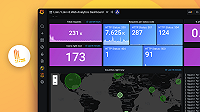Important: This documentation is about an older version. It's relevant only to the release noted, many of the features and functions have been updated or replaced. Please view the current version.
Fluentbit Loki Output Plugin
Fluent Bit is a Fast and Lightweight Data Forwarder, it can be configured with the Grafana Loki output plugin to ship logs to Loki. You can define which log files you want to collect using the Tail or Stdin input plugin. Additionally Fluent Bit supports multiple Filter and Parser plugins (Kubernetes, JSON, etc..) to structure and alter log lines.
Usage
Docker
You can run a Fluent Bit container with Loki output plugin pre-installed using our docker hub image:
docker run -v /var/log:/var/log \
-e LOG_PATH="/var/log/*.log" -e LOKI_URL="http://localhost:3100/loki/api/v1/push" \
grafana/fluent-bit-plugin-loki:latestKubernetes
You can run Fluent Bit as a Daemonset to collect all your Kubernetes workload logs.
To do so you can use our Fluent Bit helm chart:
helm repo add grafana https://grafana.github.io/helm-charts
helm repo update
helm upgrade --install fluent-bit grafana/fluent-bit \
--set loki.serviceName=loki.svc.cluster.localBy default it will collect all containers logs and extract labels from Kubernetes API (container_name, namespace, etc..).
Alternatively you can install the Loki and Fluent Bit all together using:
helm upgrade --install loki-stack grafana/loki-stack \
--set fluent-bit.enabled=true,promtail.enabled=falseAWS Elastic Container Service (ECS)
You can use fluent-bit Loki Docker image as a Firelens log router in AWS ECS. For more information about this see our AWS documentation
Local
First, you need to follow the instructions in order to build the plugin dynamic library.
The assuming you have Fluent Bit installed in your $PATH you can run the plugin using:
fluent-bit -e /path/to/built/out_grafana_loki.so -c fluent-bit.confYou can also adapt your plugins.conf, removing the need to change the command line options:
[PLUGINS]
Path /path/to/built/out_grafana_loki.soConfiguration Options
Labels
Labels are used to query logs {container_name="nginx", cluster="us-west1"}, they are usually metadata about the workload producing the log stream (instance, container_name, region, cluster, level). In Loki labels are indexed consequently you should be cautious when choosing them (high cardinality label values can have performance drastic impact).
You can use Labels, RemoveKeys , LabelKeys and LabelMapPath to how the output plugin will perform labels extraction.
AutoKubernetesLabels
If set to true, it will add all Kubernetes labels to Loki labels automatically and ignore parameters LabelKeys, LabelMapPath.
LabelMapPath
When using the Parser and Filter plugins Fluent Bit can extract and add data to the current record/log data. While Loki labels are key value pair, record data can be nested structures.
You can pass a JSON file that defines how to extract labels from each record. Each json key from the file will be matched with the log record to find label values. Values from the configuration are used as label names.
Considering the record below :
{
"kubernetes": {
"container_name": "promtail",
"pod_name": "promtail-xxx",
"namespace_name": "prod",
"labels" : {
"team": "x-men",
},
},
"HOSTNAME": "docker-desktop",
"log" : "a log line",
"time": "20190926T152206Z",
}and a LabelMap file as follow :
{
"kubernetes": {
"container_name": "container",
"pod_name": "pod",
"namespace_name": "namespace",
"labels" : {
"team": "team",
},
},
}The labels extracted will be {team="x-men", container="promtail", pod="promtail-xxx", namespace="prod"}.
If you don’t want the kubernetes and HOSTNAME fields to appear in the log line you can use the RemoveKeys configuration field. (e.g. RemoveKeys kubernetes,HOSTNAME).
Buffering
Buffering refers to the ability to store the records somewhere, and while they are processed and delivered, still be able to store more. The Loki output plugin can be blocked by the Loki client because of its design:
- If the BatchSize is over the limit, the output plugin pauses receiving new records until the pending batch is successfully sent to the server
- If the Loki server is unreachable (retry 429s, 500s and connection-level errors), the output plugin blocks new records until the Loki server is available again, and the pending batch is successfully sent to the server or as long as the maximum number of attempts has been reached within configured back-off mechanism
The blocking state with some of the input plugins is not acceptable, because it can have an undesirable side effect on the part that generates the logs. Fluent Bit implements a buffering mechanism that is based on parallel processing. Therefore, it cannot send logs in order. There are two ways of handling the out-of-order logs:
Configure Loki to accept out-of-order writes.
Configure the Loki output plugin to use the buffering mechanism based on
dque, which is compatible with the Loki server strict time ordering:[Output] Name grafana-loki Match * Url http://localhost:3100/loki/api/v1/push Buffer true DqueSegmentSize 8096 DqueDir /tmp/flb-storage/buffer DqueName loki.0
Configuration examples
To configure the Loki output plugin add this section to fluent-bit.conf
[Output]
Name grafana-loki
Match *
Url http://localhost:3100/loki/api/v1/push
BatchWait 1s
BatchSize 30720
# (30KiB)
Labels {test="fluent-bit-go", lang="Golang"}
RemoveKeys key1,key2
LabelKeys key3,key4
LineFormat key_value[Output]
Name grafana-loki
Match *
Url http://localhost:3100/loki/api/v1/push
BatchWait 1s
BatchSize 30720 # (30KiB)
AutoKubernetesLabels true
RemoveKeys key1,key2A full example configuration file is also available in this repository.
Running multiple plugin instances
You can run multiple plugin instances in the same fluent-bit process, for example if you want to push to different Loki servers or route logs into different Loki tenant IDs. To do so, add additional [Output] sections.



